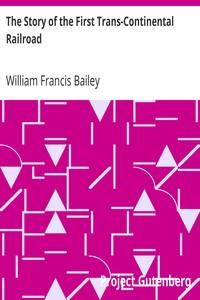Read this ebook for free! No credit card needed, absolutely nothing to pay.
Words: 42048 in 11 pages
This is an ebook sharing website. You can read the uploaded ebooks for free here. No credit cards needed, nothing to pay. If you want to own a digital copy of the ebook, or want to read offline with your favorite ebook-reader, then you can choose to buy and download the ebook.


: The Story of the First Trans-Continental Railroad Its Projectors Construction and History by Bailey William Francis - Railroads United States History; Union Pacific Railroad Company
inspired. At the time he was writing, 1835, there were seven hundred and ninety-seven miles of railroads in operation in the United States. Passenger coaches were patterned after the old stage coach, the track iron straps on wooden stringers, yet here he was outlining what today is an accomplished fact. A railroad with stone ballast from Chicago to the South Pass one branch diverging from there to the mouth of the Columbia, the other to California, traversed by trains comprised of sleeping cars, dining cars and buffet cars. The Union Pacific and its connections.
Carver spent the best years of his life and what was in those days an ample fortune in endeavoring to further his project. The great opposition to his plan arose from the proposed diversion of the public lands and the stock feature, neither Congress nor the public taking kindly to the idea of the Government giving lands for stock in a private corporation.
A third proposition was fathered by John Plumbe of Dubuque, Iowa, who suggested at a public meeting, held at his home town in March 1838, that a railroad be built from the great lakes to the Columbia River. His plan contemplated an appropriation from Congress of alternate sections of the public lands on either side of the right of way. The company to be capitalized at one hundred million dollars, twenty million shares at five dollars each. Twenty-five cents per share to be paid down to provide a fund to commence operations and subsequent assessments of like amount to be paid as the money was needed until the full amount had been paid in. One hundred miles to be constructed each year and the whole line completed in twenty years.
All of these propositions were more or less visionary and advanced by men of theory with little or no capital. They had the effect of awakening public interest and paved the way for a more feasible plan. The question of a Pacific railway, its practicability, earnings, and effect, were constantly before the people. In 1844 the idea had become firmly fixed, the leading advocate being a New York merchant named Asa Whitney, who has been called the "Father of the Pacific Railway." Mr. Whitney had spent some years in commercial life in China, returning to the United States with a competency. Becoming enthused with the idea, he put his all,--energy, time, and money into the project of a trans-continental railroad, finding many supporters. At first he advocated Carver's plan, but becoming convinced that it was not feasible, he sprung a new one of his own. He proposed that Congress should give to him, his heirs and assigns, a strip of land, sixty miles wide, with the railroad in the center, this from a point on Lake Michigan to the Pacific Coast. This land he proposed to colonize and sell to emigrants from Europe, from the proceeds build the line, retaining whatever surplus there might be after its completion, as his own.
Whitney was an indefatigable worker, thoroughly in earnest, a fluent speaker, both in public and private, well fortified with statistics and arguments. He personally travelled the whole country from Maine to fifteen miles up the Missouri River. The legislatures of Maine, New Hampshire, Vermont, Rhode Island, New Jersey, Connecticut, New York, Maryland, Ohio, Indiana, Illinois, Michigan, Tennessee, Alabama, and Georgia, all endorsed his plan by favorable resolutions.
The Senate Committee on public lands made a report recommending his proposition. Thus strongly endorsed, his plan was brought before Congress in 1848 in a bill entitled "Authorizing Asa Whitney, his heirs or assigns, to construct a railroad from any point on Lake Michigan or the Mississippi River he may designate, in a line as nearly straight as practicable, to some point on the Pacific Ocean where a harbor may be had." The road to be six foot gauge, sixty-four pound rails. The Government to establish tolls and regulate the operation of the line, Whitney to be the sole Owner and receive a salary of four thousand dollars per year for managing it.
The proposition was debated for days in the Senate and then was tabled on a vote of twenty-seven to twenty-one. The opposition dwelt largely on the length of time Whitney would necessarily require. Say he could colonize and sell a million acres a year, this would only be funds enough to build one hundred miles and consequently the two thousand miles would require at least twenty years. The defeat was largely owing to the opposition of Senator Benton of Missouri, the most pronounced friend of the West in the House, who used the argument of the power and capital it would put in the hands of one man, Whitney's. This he characterized as a project to give away an Empire, larger in extent than eight of the original states, with an ocean frontage of sixty miles, with contracting powers and patronage exceeding those of the President.
Upon the defeat of Whitney's project, Benton brought forward in 1849 one of his own for a great national highway from St. Louis to San Francisco, straight as may be, with branches to Oregon and Mexico. The Government to grant a strip one mile wide, so as to provide room for every kind of road, railway, plank, macadamized, and electric motor, or otherwise constructed where not so practicable or advantageous. Sleighs to be used during those months when snow lay on the ground. Funds for its construction to be provided by the sale of public lands. Bare in mind this was only fifty-six years ago, but eighteen years before the Union Pacific Railway was completed, and was the proposition advocated by the recognized leader of the Senate in matters western.
Up to the year 1846 when by the treaty of Guadeloupe-Hidalgo, Mexico, ceded to us California, our only territory on the Pacific Coast was Oregon and Washington. The acquisition of California, followed very shortly by the gold discoveries and the consequent influx of people, gave that state a large population and furnished a prospective business for a Pacific railway. This had heretofore been a matter of theory, very questionable, to say the least, being based on very hazy estimates of the prospective volume of trans-pacific business. With an active and aggressive population of three hundred thousand in California, practically all of eastern birth and affiliations the situation became materially changed and the necessity of railroad communication apparent. Both great political parties pledged their support in their quadrennial platforms. Presidents--Pierce, Buchanan, and Lincoln, in their several messages to Congress, strongly recommended its construction. The matter had been thoroughly discussed, both in and out of Congress and the whole country was convinced of the advisability of its construction, and only awaited a leader and a feasible plan. From 1850 to 1860 the question vied with that of slavery in public interest. Survey after survey was undertaken by the Government and private parties. Senator Benton being the first to introduce a resolution looking to the appropriation of sufficient money to pay for a survey. This being in 1851. The question of the North and South, entered into the matter, as it did everything else in the days preceding the Rebellion. "You shall not build through free soil," said the South and "we won't permit it to run through the Slave States," said the North. Compromise was out of the question, and it was not until the southern element had been eliminated from Congress by their secession was any action possible.
It was found that private corporations, duly aided by land grants from the Government, were able to build the necessary connecting links through the comparatively level country, between Chicago and St. Louis, and the Missouri River. From the Missouri River west it was felt that the undertaking was too great for any one set of men or corporation, besides local interests in California were already in the field, consequently two companies were determined upon, one of them working eastward, the other westward, and it was thus arranged.
Situation 1861--Curtis Bill of 1862--Amended Charter of 1864--Further Amendments--1866--Legal Complications in New York--Controversy With Central Pacific.
Commencing with the session of 1835, when a memorial on the subject of railroad communication between Lake Michigan and the Pacific Coast, was presented by Hartwell Carver, up to the present, the Pacific Railways have been ever present in Congress. The Catalogue of Government Publications gives one hundred and eighty-five having the Union Pacific, or Pacific Railroads as their subject.
Free books android app tbrJar TBR JAR Read Free books online gutenberg
More posts by @FreeBooks

: Colonial Records of Virginia by Various - Virginia History Colonial period ca. 1600-1775 Sources United States



: How to Write Clearly: Rules and Exercises on English Composition by Abbott Edwin Abbott - English language Composition and exercises Children's Instructional Books





